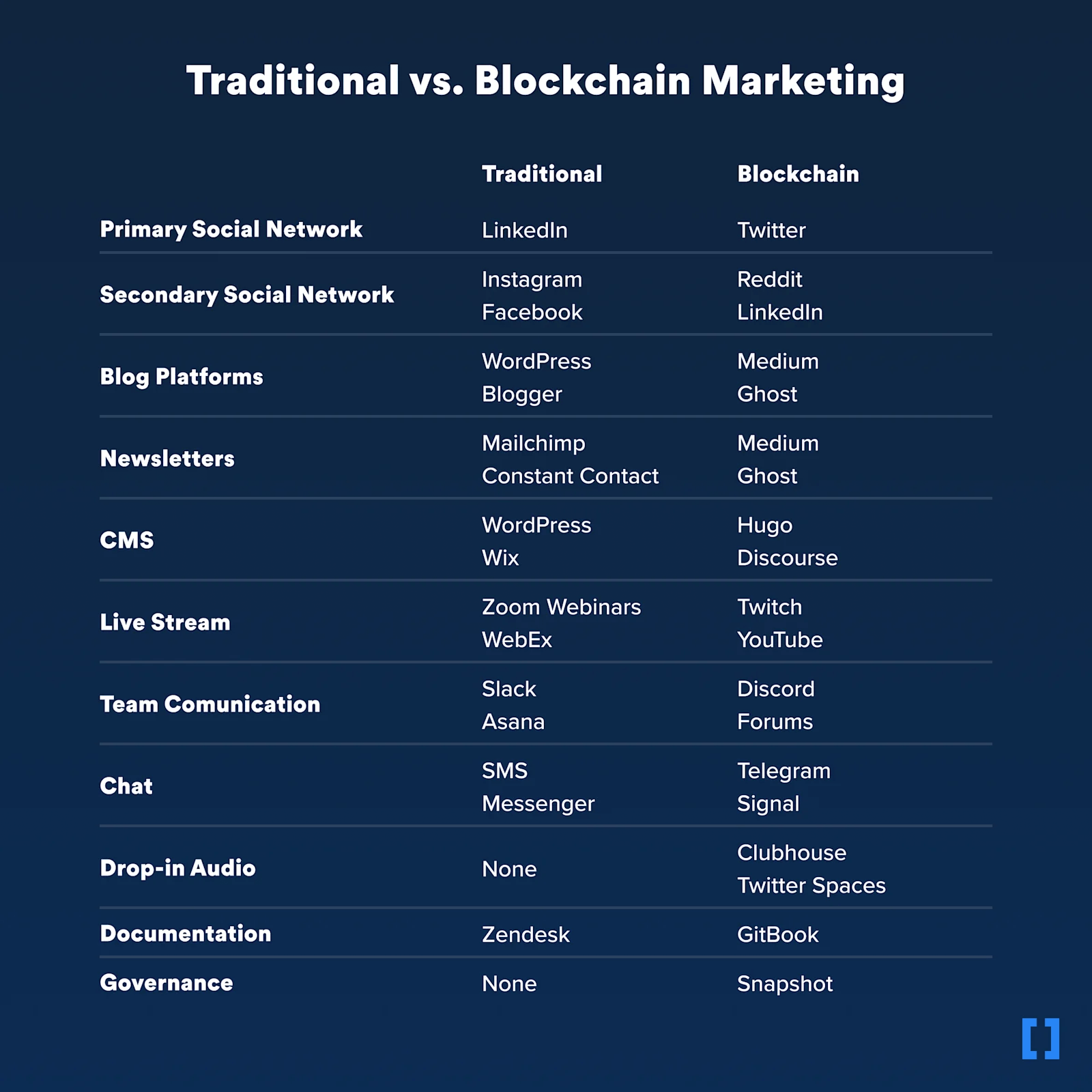Blockchain technology will disrupt every industry over the next two decades.
Because there is no good source that explains the nuances of blockchain marketing compared to traditional marketing tech stacks and strategies we decided to create a series dedicated to exploring this new marketing niche.
What is Blockchain Marketing?
Blockchain marketing is a collection of marketing communication tools, strategies, and channels for promoting blockchain companies and crypto startups to crypto natives and mainstream organizations alike.
Blockchain marketing is different from traditional product marketing in a few ways:
- The underlying technology and language used to describe blockchain is complex
- The technology is often open-sourced, community-supported, and community governed
- The blockchain industry and its global adoption is still in their infancy
This confluence of unique properties leads to creative marketing strategies, non-traditional marketing communication platforms, and forces traditional marketers to fundamentally rethink how they promote clients in the crypto industry.
Blockchain Marketing Audiences
When we think of crypto marketing, we consider two primary audiences for our clients: traditional end-users and crypto-native end users.
Traditional End Users
Consider Circle who created the fiat-backed stablecoin, USDC, and now develops a suite of APIs to enable corporate treasury departments to use USDC to automate payments, payouts, and earn high interest on stablecoin reserves.
The way Circle's product marketing team communicates their value proposition, features, and benefits of their API suite to a CFO at a multi-national company like Uber or Exxon Mobil will be quite different from how they communicate their blockchain SaaS solution to a global cryptocurrency exchange like FTX.
Traditional end users will likely discover blockchain solutions on traditional social media channels (e.g. LinkedIn), consume content that is presented in familiar ways (e.g. email marketing, white papers, eBooks, webinars, etc.), and cognize the information when it’s described with common terms and familiar use cases.
Crypto-Native End Users
If you’re like Blocknative, the leading mempool monitoring platform for public, layer 1 blockchains like Ethereum, your clients are DeFi protocols like Compound, Curve, and Synthetix who have a deep technical understanding of blockchain technology.
One area where traditional and blockchain marketing processes agree is persona development. By splitting users up into these two buckets, discovering their interests, needs, motivations, channels, and demographics you will be able to personalize a blockchain marketing strategy that resonates with your ideal customers.
Blockchain's New Marketing Model
We’ve all heard of business-to-business (B2B) and business-to-consumer (B2C) marketing models, and while these hold true for some blockchain companies like centralized exchanges, they miss the mark when it comes to the marketing environment of open-source, community-supported protocols.
Community-to-Customer (C2C)
Many blockchain protocols and their code is open-sourced, maintained by a core group of dedicated developers, or a consortium like Centre in the case of USDC, and expanded upon by community stakeholders through forum discussions, improvement proposals, and governance with voting tools like Snapshot.
When there are multiple DeFi or Web3 protocols building on top of layer 1 blockchains, each community takes responsibility for marketing not only their product to investors and users but the layer 1 smart contract platform it's built on.
In this way, communities unite together to promote their crypto startup, the blockchain they are building on, and their ecosystem of partner protocols.
One area where we see this in action is crypto podcasts. For example, the FTX podcast, with its deep ties to Solana, hosts many builders, investors, and founding team members on their podcast to promote the larger ecosystem.
C2C Marketing Example: Raydium, Solana, and Serum
Raydium is a decentralized exchange that uses a hybrid Automated Market Maker protocol to give retail investors a fast and easy way to buy and sell tokens.
Raydium is built on Solana, which affords Raydium's users extremely fast settlement times (400-millisecond blocks), and cheap gas fees (pennies, not dollars).
Raydium also passes around 50% of their orders to Serum's decentralized central limit order book to get even better prices on their user's trades.
In this way, Raydium's users not only promote the DEX of their choice, but also Solana (the layer 1 smart contract platform), and Serum (the ecosystem partner protocol).
Here are some tactics Raydium and Serum use to community-hack new users:
- Listing new tokens on their exchanges (initial exchange offering)
- Adding yield farming pairs where holders can provide liquidity in return for high interest
- Promoting new crypto startups with incubator-style support (re: AcceleRAYtor)
- Sponsoring Solana's hackathon (re: Solana's DeFi Hackathon)
If you're a blockchain marketing firm tasked with growing daily active users for an up-and-coming protocol, your job is to activate your community through giveaways, contests, hackathons, partnerships, collaborations, integrations, and cross-promotion.
Crypto token holders are as passionate as - if not more passionate - than any sports fan. You might only find more die-hard fans in r/wallstreetbets for companies like Tesla, GameStop, and meme stocks like AMC.
This distinction between business-led, B2B marketing efforts versus community-driven C2C marketing underpins so much of the strategies we explore in this series.
Next, let’s look at some common blockchain marketing themes.
Blockchain Marketing Themes
As blockchain marketers and investors, we’ve observed a few themes that permeate the tools, technology, and strategies that winning companies and decentralized autonomous organizations (DAOs) use to scale their protocol.
1. High Availability
The crypto market is borderless and open 24 hours a day, 365 days a year.
This "always-on" availability is something that users come to expect, and when treated properly, builds a fanatic community that is always expanding.
Many projects leverage mass communication tools like Forums, Discord, and Twitter to connect and collaborate around the clock and around the world.
High availability also means accessibility.
When founders and core developers are directly accessible to the community through Twitter DMs or Clubhouse calls, it connects audiences directly into the mission more so than static videos posted on YouTube.
While not every project will want the founding team to be public figures, having public figures for press opportunities, podcasts, governance calls, and answering questions in Discord establishes authentic relationships between an open-sourced blockchain project and the community that believes in its mission.
2. Open Networks
One of the most attractive aspects of crypto and decentralized finance (DeFi) is its inclusive and open nature. Anyone with a smartphone and an internet connection can participate in these new financial networks and creator communities.
Since so much technology is built, supported, promoted, and used by communities that find value from them, crypto startups and DAOs create open internet communities where members can share memes like on Reddit and participate in governance by voting on protocol improvement proposals.
3. Free Tools
Because early-stage blockchain startups are community-run and bootstrapped, they tend to rely on free tools to jumpstart their community-building efforts.
Everything from messaging platforms like Telegram, to email newsletter platforms like Substack and Revue, and blogging platforms like Medium and Ghost, community-led blockchain projects are forced to be resourceful.
4. Built to Scale
If you’re trying to decentralize everything that currently exists as a centralized, private product or service then you need to keep scalability in mind from the start.
The need to scale is one reason why we see crypto upstarts adopt free platforms like Twitch and YouTube for live streaming and building guided video walkthroughs.
Traditional vs. Blockchain Marketing Tools
While the fundamentals of traditional marketing strategies extend to blockchain marketing such as persona development, content marketing, empathy mapping, the buyer’s journey, and flywheels, how they are applied is slightly different.
Here is a high-level comparison across a few important categories:

Traditional vs Blockchain Marketing Table
Blockchain Marketing Tech Stack
Because of the parameters and unique characteristics of the crypto industry, today’s blockchain MarTech stacks look remarkably different.
Just about everything crypto startups use today to build, manage, and communicate with their audience subverts what we are used to as “traditional” marketers.
Are you ready to scale your blockchain company? Contact our sales team to start a project or send us a DM on Twitter (@webstacks_) if you prefer to stay anonymous.




